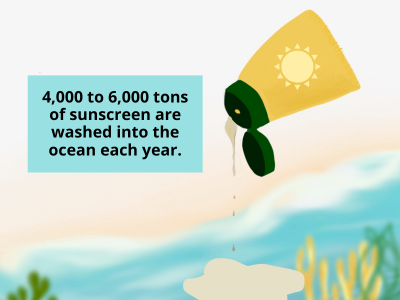Sunscreen’s effects from beach to bleach

Graphic illustration by Eileen Zhu, Deeksha Raj and Jasmine Rihal
Chemicals released into the ecosystem affecting marine life.
June 2, 2023
Despite its obvious benefits in preventing sunburn, skin cancer and premature aging, modern sunscreen is often released into marine ecosystems, where it can take a detrimental toll on marine life.
Oxybenzone is found in 80 percent of chemical sunscreens. It not only poses a danger to marine life but is also the most frequently detected sunscreen chemical in natural waters. It is known to prevent skin aging; however, it dissolves easily in water and does not readily biodegrade.
One of oxybenzone’s most devastating forms of destruction is coral bleaching in hard corals, otherwise referred to as reef-building corals, which grow in colonies. Many forms of marine life depend on coral reefs for food and shelter, and any damage from coral bleaching causes a major decline in biodiversity.
“Sunscreen is usually diluted in the water, where it has an effect on small organisms like algae in the corals or the embryos of invertebrates like sea urchins,” said Julie Pourtois, a fourth-year Ph.D. student in Stanford University’s Hopkins Marine Station. “Over time, we may start to see effects on bigger organisms like fish and other marine animals that live close to the coast.”
Moreover, oxybenzone often causes DNA damage to other marine life, which disrupts an organism’s endocrine system — an internal system responsible for relaying hormones, leading to reproductive and developmental problems.
The two main forms of sunscreen sold are chemical and mineral sunscreens. Chemical sunscreens are known to include toxic chemicals, whereas mineral sunscreens are generally recognized as harmless. Despite being the healthier option, mineral sunscreens are often avoided, as they leave white residue on one’s skin. Wearing sunscreen that seamlessly blends into the skin may be more appealing for many people.
“People may not know which ingredients are harmful or harmless to them and the environment,” biology and physiology teacher Jason Lee said. “Everyone votes with their dollar, so when you’re buying chemical sunscreens, you are telling companies that this is what the customers want.”
Some states have already taken action in an attempt to limit the negative effects of sunscreen on the environment. On Jan. 1, 2022, Hawaii banned the sale of non-mineral sunscreen, prohibiting most sunscreens that contain oxybenzone and octinoxate.
While the purpose of sunscreen is to protect the human skin from radiation, its destructive effects on marine life may be overlooked. As the issue has become increasingly dire, people are making progressive efforts to preserve a green planet by keeping track of their waste footprint, spreading awareness and using eco-friendly options.
“In the future, I just hope that we’ll be making new sunscreens that are safer for the environment, as well as new experiments to give us a better understanding of the way different sunscreen ingredients affect marine life,” Pourtois said.




























































